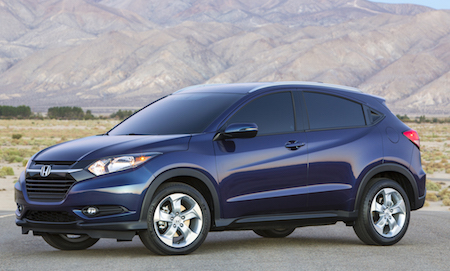2016 Honda HR-V – Perfectly Pleasant
- April 30, 2015
- Fiat, Honda, Jeep, Mini, More Categories...
- Posted by George Peterson
- Comments Off on 2016 Honda HR-V – Perfectly Pleasant
 Honda launches its all-new 2016 HR-V sub-compact crossover sport utility vehicle in May, 2015. The 2016 Honda HR-V, based on Honda’s diminutive Fit sub-compact, is very spacious for what it is. The interior – at least the passenger compartment – feels about as big as the larger Honda CR-V. HR-V’s wheelbase is only a half inch shorter than CR-V allowing the big seating area, but its overall length is about ten inches shorter – less cargo room. The front seating area feels wider than you would expect in a vehicle this small. Ingress and egress are easy to the front seats. The rear seats are a bit tight. You have to maneuver your feet to get between the B-pillar and the seat and there is not much knee room. Cargo room is larger than it looks. The best feature Honda takes from the architecture of the Fit are the “Magic Seat” rear seats that flip and fold several ways to maximize the flexibility of the area behind the front seats.
Honda launches its all-new 2016 HR-V sub-compact crossover sport utility vehicle in May, 2015. The 2016 Honda HR-V, based on Honda’s diminutive Fit sub-compact, is very spacious for what it is. The interior – at least the passenger compartment – feels about as big as the larger Honda CR-V. HR-V’s wheelbase is only a half inch shorter than CR-V allowing the big seating area, but its overall length is about ten inches shorter – less cargo room. The front seating area feels wider than you would expect in a vehicle this small. Ingress and egress are easy to the front seats. The rear seats are a bit tight. You have to maneuver your feet to get between the B-pillar and the seat and there is not much knee room. Cargo room is larger than it looks. The best feature Honda takes from the architecture of the Fit are the “Magic Seat” rear seats that flip and fold several ways to maximize the flexibility of the area behind the front seats.
Positioning Challenge Honda’s description of the target market for the HR-V encompasses practically everybody. They see students through empty nesters and everybody in between as prospective buyers. And we can believe it. The HR-V is so good that it could cannibalize sales from Honda’s top selling XSUV – the CR-V. To somewhat neuter the HR-V, Honda has fitted a smaller 141-horsepower 1.8L 4-cylinder engine (CR-V has a 185HP 2.4L 4-cylinder) and limited available features. For instance, power front seats are not offered nor is a remote system for garage doors (Homelink). These would be expected in a vehicle targeted at Baby Boomers wanting to downsize. After all, some if not all of their previous vehicles likely were fitted with these features. But adding them would make the reason to move up to the CR-V less convincing. Honda management utters “those features are not for this price point” (but Renegade has power seats, at least).
Magic Seat Unique Feature The Magic Seat provides the HR-V with an extremely flexible rear area. In Utility Mode, both second row seats are folded down providing the maximum cargo capacity behind the front seats. In Long Mode, the front passenger seat also folds down to allow long objects to be carried. In Tall Mode, the seat cushion of the second row seat folds up leaving floor to ceiling space free.
Driving the 2016 Honda HR-V The best way to describe the driving experience of the Honda HR-V is “pleasant”. The vehicle is not exciting to drive, but very predictable. The ride is comfortable. The handling is stable and solid. The 141-horsepower 4-cylinder is mated to a continuously variable transmission in the upper EX and EX-Navi models. The CVT is optional in the base LX trim. Think of the HR-V as an around town cruiser and grocery getter, not a canyon blaster. In fact, the most off road Honda allowed in a drive from Miami Beach to the Everglades was to park some of the HR-Vs on the grass at a lunch stop.
How Will It Sell? This market segment is one of the hottest in the market today. Products like the Jeep Renegade, Fiat 500X, Mazda CX-3, MINI Countryman, Buick Encore, Chevrolet Trax are part of the competitive set. On the fun to drive side of the market Renegade and 500X are probably the benchmarks. On the sedate side of the market you can list Encore and Trax. Put the 2016 Honda HR-V somewhere in the middle. The HR-V’s base price is $19,115 with for a LX model with manual transmission. This makes it one of the least expensive base XSUVs. Calculating dollars per cubic feet of space occupied, only the Jeep Compass, Jeep Patriot and Jeep Renegade are less expensive. Check all the boxes for a EX-L with Navi and you can probably get the price up to $28,000. AutoPacific’s forecast for HR-V’s first full year on the market (2016) is about 41,000 units – well below the forecast for the CR-V at about 302,000 units.

